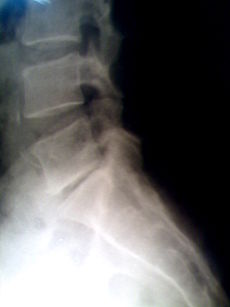- Spondylosis
-
Spondylosis Classification and external resources 
ICD-10 M47 ICD-9 721 OMIM 184300 DiseasesDB 12323 MedlinePlus 000436 eMedicine neuro/564 MeSH D013128 Spondylosis is a term referring to degenerative osteoarthritis of the joints between the centra of the spinal vertebrae and/or neural foraminae. If this condition occurs in the zygapophysial joints, it can be considered facet syndrome. If severe, it may cause pressure on nerve roots with subsequent sensory and/or motor disturbances, such as pain, paresthesia, or muscle weakness in the limbs.
When the space between two adjacent vertebrae narrows, compression of a nerve root emerging from the spinal cord may result in radiculopathy (sensory and motor disturbances, such as severe pain in the neck, shoulder, arm, back, and/or leg, accompanied by muscle weakness). Less commonly, direct pressure on the spinal cord (typically in the cervical spine) may result in myelopathy, characterized by global weakness, gait dysfunction, loss of balance, and loss of bowel and/or bladder control. The patient may experience a phenomenon of shocks (paresthesia) in hands and legs because of nerve compression and lack of blood flow. If vertebrae of the neck are involved it is labelled cervical spondylosis. Lower back spondylosis is labeled lumbar spondylosis.
Contents
Causes
- Repetitive strain injury caused due to lifestyle without ergonomic care, e.g., while working in front of computers, driving, traveling etc. Simple reasons like "using a blunt knife for everyday chopping of vegetables" could cause RSI.
- Others
Diagnosis
- Spurling's test
- pain while coughing with neck in hyperextended position
Treatment
Treatment is usually conservative in nature; the most commonly used treatments are chiropractic, osteopathy, physiotherapy and other manual medicine practices. Patient education on lifestyle modifications and nonsteroidal anti-inflammatory drugs (NSAIDs) have been shown to manage such conditions. Alternative therapies such as osteopathic manipulative medicine (OMM), massage, trigger-point therapy, chiropractic, osteopathic care, yoga and acupuncture may be utilized to control pain and maintain musculoskeletal function in some people. Surgery is occasionally performed.
Many of the treatments for cervical spondylosis have not been subjected to rigorous, controlled trials. Surgery is advocated for cervical radiculopathy in patients who have intractable pain, progressive symptoms, or weakness that fails to improve with conservative therapy. Surgical indications for cervical spondylosis with myelopathy (CSM) remain somewhat controversial, but "most clinicians recommend operative therapy over conservative therapy for moderate-to-severe myelopathy." (Baron, M.E.)
Physical therapy and chiropractic care may be effective for restoring range of motion, flexibility, and core strengthening. Decompressive therapies (i.e. manual mobilization, mechanical traction) may also help alleviate pain. However, physical therapy and chiropractic cannot "cure" the degeneration, and some people view that strong compliance with postural modification is necessary to realize maximum benefit from decompression, adjustments, and flexibility rehabilitation.
It is often argued, however, that the cause of spondylosis is simply old age, and that posture modification treatment is often practiced by those who have a financial interest (such as Worker's Compensation) [1] in proving that it is caused by work conditions and poor physical habits. Understanding anatomy is the key to conservative management of spondylosis.
Surgery
Many surgical procedures have been developed to alleviate the signs and symptoms associated with spondylosis. The vertebral column can be approached by the surgeon from the front, side, or rear. Osteophytes and sometimes portions of an intervertebral disc are commonly removed in an effort to relieve pressure on adjacent nerve roots and/or the spinal cord.
Complications
A major problem related to this disease is vertebrobasilar insufficiency. This is a result of the vertebral artery becoming occluded as it passes up in the transverse foramen. The spinal joints become stiff in cervical spondylosis. Thus the chondrocytes which maintain the disc become deprived of nutrition and die. The weakened disc bulges and grows out as a result of incoming osteophytes. A ‘drop attack’ in older people is a sign of vertebrobasilar insufficiency, which is the cause of 25% of the strokes and TIA’s in the USA.
See also
References
- Thomas, Clayton L. (1985). Taber's Cyclopedic Medical Dictionary. F.A. Davis Company, Philadelphia, Pennsylvania. ISBN 0-8036-8309-X.
- Baron, M. E. (2007). Cervical Spondylosis: Diagnosis and Management. http://www.emedicine.com/neuro/topic564.htm
- Towel hot compress can cure 10 kinds of disease . http://www.worldhealthlife.com/towel-hot-compress-cure-disease.html[dead link]
- ^ Rana, Sandeep, "Cervical Spondylosis, Diagnosis and Management: eMedicine Neurology", "http://emedicine.medscape.com" (March 24, 2010).
External links
- Cure for Cervical spondylosis through yoga at the Cervical Spondylosis
- Cervical spondylosis at the Mayo Clinic
Dorsopathies / spinal disease (M40–M54, 720–724, 737) Deforming dorsopathies OtherSpondylopathy inflammatory: Spondylitis (Ankylosing spondylitis) · Sacroiliitis · Discitis · Spondylodiscitis · Pott diseaseBack pain Intervertebral disc disorder M: JNT
anat(h/c, u, t, l)/phys
noco(arth/defr/back/soft)/cong, sysi/epon, injr
proc, drug(M01C, M4)
Categories:- Skeletal disorders
- Vertebral column disorders
Wikimedia Foundation. 2010.
